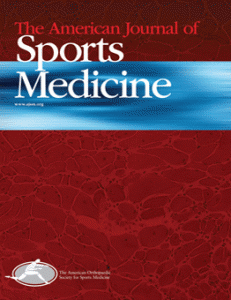The Effect of Platelet-Rich Fibrin Matrix on Rotator Cuff Tendon Healing, A Prospective, Randomized Clinical Study
Scott A. Rodeo, MD*,†,Demetris Delos, MD†,Riley J. Williams, MD†,Ronald S. Adler, MD, PhD†,Andrew Pearle, MD† andRussell F. Warren, MD††Sports Medicine and Shoulder Service, The Hospital for Special Surgery, New York, New York
Investigation performed at Sports Medicine and Shoulder Service, The Hospital for Special Surgery, New York, New York?* Scott A. Rodeo, MD, The Hospital for Special Surgery, 535 East 70th Street, New York, NY 10021 (e-mail: rodeos@hss.edu).Presented at the interim meeting of the AOSSM, San Diego, California, February 2011
Am J Sports Med June 2012 vol. 40 no. 6 1234-1241 
Background: The process of tendon-bone healing, like following a rotator cuff repair has been shown to be promoted by exogenous growth factors like BMP-2 and TGF-?. Platelet with its ? granules is a rich source of growth factors and different platelet rich preparations have been used to promote tendon healing with conflicting results.
Objective: This level 2 randomised trial was aimed to assess the effect of platelet rich fibrin matrix on tendon healing and clinical outcome in patients undergoing rotator cuff repair.
Patients: 79 patients who underwent rotator cuff repair were intra-operatively randomized to receive PRFM at the tendon-bone interface (n = 40) and standard repair only (n = 39).
Methods: Primary outcome assessed was tendon healing (intact or defect at repair site) as evaluated with ultrasound at 6 and 12 weeks. Vascularity in peribursal, peritendinous, musculotendinous and insertion site was assessed using power Doppler ultrasound. Secondary outcome measures included shoulder outcome scales (ASES and L’ Insalata) and strength assessments. A logistic regression model was used to predict outcome based on platelet count, treatment type and tear severity.
Results: There was no difference in healing or vascularity between 2 groups (P = 0.20) as evidenced by ultrasound at 6 and 12 weeks. Outcome scores gradually improved over time but no difference was found between 2 groups. Platelet count had no effect on healing. Logistic regression analysis showed that PFRM was a significant predictor (P = 0.037) for a tendon defect at 12 weeks (Odds ratio 5.8).
Conclusions:
PRFM used at the tendon bone interface had no quantifiable effect on tendon healing, tendon vascularity, strength and clinical outcome scales. Logistic regression analysis showed PFRM may have a negative effect on tendon healing.
Ref
1. http://m.ajs.sagepub.com/content/40/6/1234.abstract
Leave a Reply